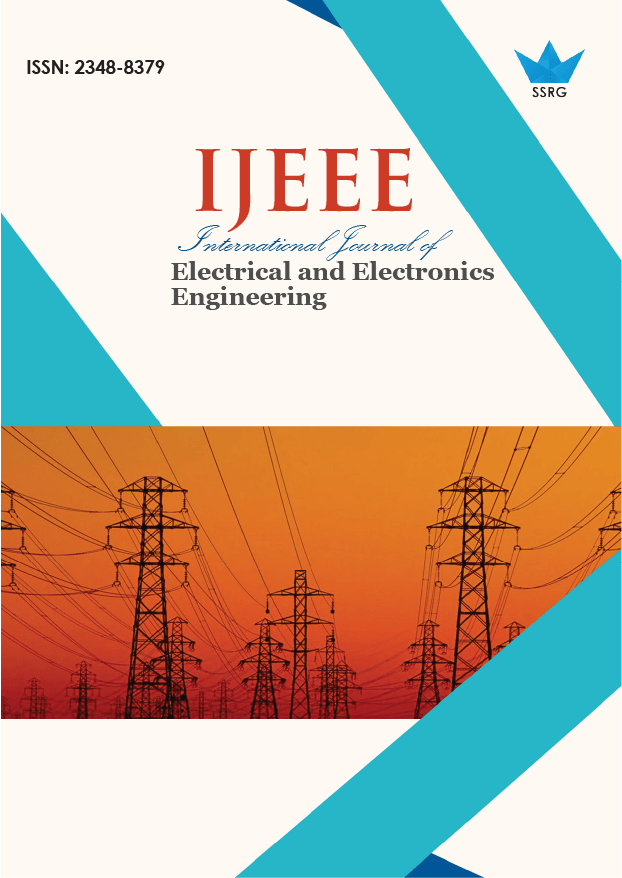Area Efficient Full Subtractor Design for Quantum-Dot Cellular Automata

| International Journal of Electrical and Electronics Engineering |
| © 2024 by SSRG - IJEEE Journal |
| Volume 11 Issue 12 |
| Year of Publication : 2024 |
| Authors : Gurram Umadevi, Kanaka Durga Ganapavarapu, Chandra Sekhar Paidimarry |
How to Cite?
Gurram Umadevi, Kanaka Durga Ganapavarapu, Chandra Sekhar Paidimarry, "Area Efficient Full Subtractor Design for Quantum-Dot Cellular Automata," SSRG International Journal of Electrical and Electronics Engineering, vol. 11, no. 12, pp. 53-60, 2024. Crossref, https://doi.org/10.14445/23488379/IJEEE-V11I12P105
Abstract:
QCA technology represents a disruptive nanoelectronics paradigm characterized by its terahertz speed, reduced energy consumption, and potential for very high device density. Full subtractors play a crucial role in the Digital Signal Processing (DSP) systems for arithmetic operations and binary data manipulation. This article proposes a dedicated QCA Full-Subtractor (QFS) design to leverage electrostatic intercellular interaction. The proposed QFS design does not utilize any majority gate, greatly diminishing the cell count, required area, and performance. This novel design requires only 15 QCA cells with 7644.00 nm2 area and 0.5 latency. Functional validation and energy calculations are evaluated using the tool QCA Designer-E.
Keywords:
Area efficiency, Electrostatic interaction, Full Subtractor, QCA, Nanoelectronics.
References:
[1] R.H. Dennard et al., “Design of Ion-implanted MOSFET’S with Very Small Physical Dimensions,” IEEE Journal of Solid-State Circuits, vol. 9, no. 5, pp. 256-268, 1974.
[CrossRef] [Google Scholar] [Publisher Link]
[2] Kerry Bernstein et al., “Device and Architecture Outlook for beyond CMOS Switches,” Proceedings of the IEEE, vol. 98, no. 12, pp. 2169-2184, 2010.
[CrossRef] [Google Scholar] [Publisher Link]
[3] Nor Zaidi Haron, and Said Hamdioui, “Why is CMOS Scaling Coming to an END?,” 2008 3rd International Design and Test Workshop, Monastir, Tunisia, pp. 98-103, 2008.
[CrossRef] [Google Scholar] [Publisher Link]
[4] C.S. Lent et al., “Quantum Cellular Automata,” Nanotechnology, vol. 4, no. 1, 1993.
[CrossRef] [Google Scholar] [Publisher Link]
[5] C.S. Lent, and P.D. Tougaw, “A Device Architecture for Computing with Quantum Dots,” Proceedings of the IEEE, vol. 85, no. 4, pp. 541-557, 1997.
[CrossRef] [Google Scholar] [Publisher Link]
[6] Wolfgang Porod, “Quantum-Dot Devices and Quantum-Dot Cellular Automata,” Journal of the Franklin Institute, vol. 334, no. 5-6, pp. 147-1175, 1997.
[CrossRef] [Google Scholar] [Publisher Link]
[7] P. Douglas Tougaw, Craig S. Lent, and Wolfgang Porod, “Bistable Saturation in Coupled Quantum‐Dot Cells,” Journal of Applied Physics, vol. 74, no. 5, pp. 3558-3566, 1993.
[CrossRef] [Google Scholar] [Publisher Link]
[8] P. Douglas Tougaw, and Craig S. Lent, “Logical Devices Implemented Using Quantum Cellular Automata,” Journal of Applied physics, vol. 75, no. 3, pp. 1818-1825, 1994.
[CrossRef] [Google Scholar] [Publisher Link]
[9] Dhrubajyoti Bhowmik et al., “Systematic Cell Placement in Quantum-Dot Cellular Automata Embedding Underlying Regular Clocking Circuit,” IET Circuits Devices & Systems, vol. 15, pp. 156-167, 2021.
[CrossRef] [Google Scholar] [Publisher Link]
[10] Amit Kumar Pramanik et al., “Design and Analysis of Regular Clock Based 2: 4 Decoder Using T-Gate in QCA,” Proceedings of Second Asian Symposium on Cellular Automata Technology, pp. 81-91, 2023.
[CrossRef] [Google Scholar] [Publisher Link]
[11] S. Karthigai Lakshmi et al., “Design of Subtractor Using Nanotechnology Based QCA,” 2010 International Conference on Communication Control and Computing Technologies, Nagercoil, India, pp. 384-388, 2010.
[CrossRef] [Google Scholar] [Publisher Link]
[12] N. Prameela Kumari, and K.S. Gurumurthy, “QCA System Design Using Blocks with Vertically Stacked Active Elements,” 2014 2nd International Conference on Devices, Circuits and Systems (ICDCS), Coimbatore, India, pp. 1-6, 2014.
[CrossRef] [Google Scholar] [Publisher Link]
[13] H. Dallaki, and M. Mehran, “Novel Subtractor Design Based on Quantum-Dot Cellular Automata (QCA) Nanotechnology,” International Journal of NanoScience and Nanotechnology, vol. 11, no. 4, pp. 257-262, 2015.
[Google Scholar] [Publisher Link]
[14] C. Labrado, and H. Thapliyal, “Design of Adder and Subtractor Circuits in Majority Logic‐Based Field‐Coupled QCA Nanocomputing,” Electronics Letters, vol. 52, no. 6, pp. 464-466, 2016.
[CrossRef] [Google Scholar] [Publisher Link]
[15] Peer Zahoor Ahmad et al., “Design of Novel QCA-Based Half/Full Subtractors,” Nanomaterials and Energy, vol. 6, no. 2, pp. 59-66, 2017.
[CrossRef] [Google Scholar] [Publisher Link]
[16] S.S. Ramachandran, and K.J. Jegadish Kumar, “Design of a 1-Bit Half and Full Subtractor Using a Quantum-Dot Cellular Automata (QCA),” 2017 IEEE International Conference on Power, Control, Signals and Instrumentation Engineering (ICPCSI), Chennai, India, pp. 2324-2327, 2017.
[CrossRef] [Google Scholar] [Publisher Link]
[17] Ramanand Jaiswal, and Trailokya Nath Sasamal, “Efficient Design of Full Adder and Subtractor Using 5-Input Majority Gate in QCA,” 2017 Tenth International Conference on Contemporary Computing (IC3), Noida, India, pp. 1-6, 2017.
[CrossRef] [Google Scholar] [Publisher Link]
[18] Mohammad Mosleh, “A Novel Full Adder/Subtractor in Quantum-Dot Cellular Automata,” International Journal of Theoretical Physics, vol. 58, pp. 221-246, 2019.
[CrossRef] [Google Scholar] [Publisher Link]
[19] Md. Abdullah-Al-Shafi, and Ali Newaz Bahar, “An Architecture of 2-Dimensional 4-Dot 2-Electron QCA Full Adder and Subtractor with Energy Dissipation Study,” Active and Passive Electronic Components, vol. 2018, no. 1, 2018.
[CrossRef] [Google Scholar] [Publisher Link]
[20] Ali Newaz Bahar, and Khan A. Wahid, “Design and Implementation of Approximate DCT Architecture in Quantum-Dot Cellular Automata,” IEEE Transactions on Very Large Scale Integration (VLSI) Systems, vol. 28, no. 12, pp. 2530-2539, 2020. [CrossRef] [Google Scholar] [Publisher Link]
[21] Ismail Gassoumi, Lamjed Touil, and Abdellatif Mtibaa, “An Efficient Design of QCA Full‐Adder‐Subtractor with Low Power Dissipation,” Journal of Electrical and Computer Engineering, vol. 2021, no. 1, 2021.
[CrossRef] [Google Scholar] [Publisher Link]
[22] Mehdi Hosseinzadeh et al., “Design and Simulation of Full-Subtractor Based on Quantum-Dot Cellular Automata Technology,” AEU-International Journal of Electronics and Communications, vol. 171, 2023.
[CrossRef] [Google Scholar] [Publisher Link]
[23] Frank Sill Torres et al., “An Energy-Aware Model for the Logic Synthesis of Quantum-Dot Cellular Automata,” IEEE Transactions on Computer-Aided Design of Integrated Circuits and Systems, vol. 37, no. 12, pp. 3031-3041, 2018.
[CrossRef] [Google Scholar] [Publisher Link]
[24] Mohsen Hayati, and Abbas Rezaei, “Design of Novel Efficient Adder and Subtractor for Quantum-Dot Cellular Automata,” International Journal of Circuit Theory and Applications, vol. 43, no. 10, pp. 1446-1454, 2015.
[CrossRef] [Google Scholar] [Publisher Link]

 10.14445/23488379/IJEEE-V11I12P105
10.14445/23488379/IJEEE-V11I12P105